We may earn a commission if you make a purchase through the links on our website.
8 Best Tools for IoT Software Monitoring
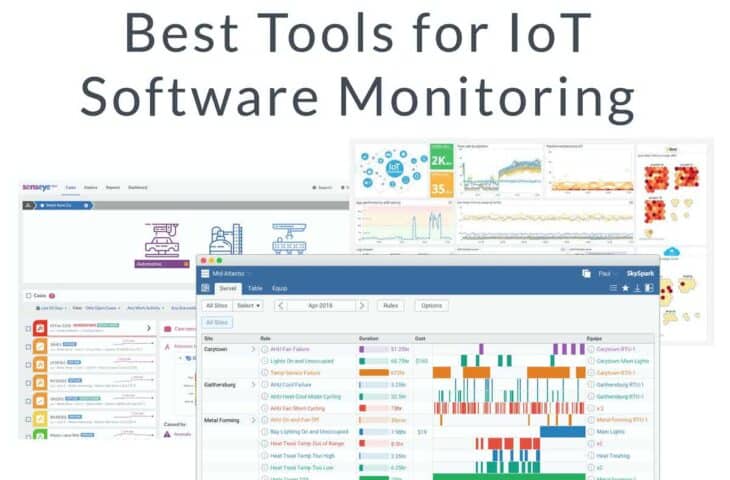
UPDATED: October 12, 2022
With vast IoT device rollouts being expected across several industries, you need the best tool to keep track of your remote endpoints. This article covers the best industrial IoT monitoring solutions available today.
Across many industries, IoT (Internet of Things) is becoming a widespread solution to the problem of remote device control and management. With network integration being vital for businesses that need to keep up with increasing technological demands, it makes sense for more and more devices to be connected to our existing systems.
Here is our list of the best tools for IoT software monitoring:
- Skyspark A scalable IoT monitoring solution that can handle a broad spectrum of IoT devices. By effectively integrating with any Java-capable device, Skyspark can work regardless of whatever use case is required.
- Senseye PdM An industrial IoT monitoring and management suite designed specifically for factory-floor equipment is the best in the business if you need to specialize in IoT-driven manufacturing.
- Datadog IoT Monitoring Another specialized industrial IoT monitoring and management platform, designed specifically for transport and logistics industries, with mapping and location-based data aggregation.
- Teamviewer IOT A flexible IoT solution provides a substantial monitoring and alerts system backed up by a broad range of integrative IoT solutions.
- Hologram IoT A cellular IoT monitoring platform. Hologram lacks much of the flexibility of other solutions, but if you rely on specifically cellular-usage data tracking on IoT devices, this is the best option for you.
- OpenRemote The only open-source and completely free solution on this list. If you have the development capabilities and are working on a budget, OpenRemote will undoubtedly be configurable for your needs.
- Particle A combined software and hardware package built around cellular development boards akin to an Arduino kit. Particle has a very flexible data plan system for any business size.
- AWS IoT Device Management An optional expansion for the AWS platform. While this solution lacks much monitoring as standard, it may be the best option if you’re already working on the AWS platform and need to integrate and roll out some IoT devices.
To aid with this new wave of hardware connectivity, IoT software monitoring tools help bridge the gap between typically obtuse equipment like transportation, power, and cooling, or manufacturing hardware. In addition, IoT monitoring tools allow you to dive down into the particulars of such equipment and expose crucial information like temperature, location, or even faulty components.
The solutions on this list can be broadly categorized into two:
- Flexible solutions such as OpenRemote or Skyspark are designed to work on many IoT systems. These are the best option if you use different types of IoT, like combining securing cameras with manufacturing hardware, for example.
- Specialist solutions such as Datadog or Senseye PdM are built to perform a specific function. Therefore, you should consider your IoT needs and use a specialist solution only if you heavily depend on that particular function.
The best Tools for IoT Software Monitoring
1. Skyspark
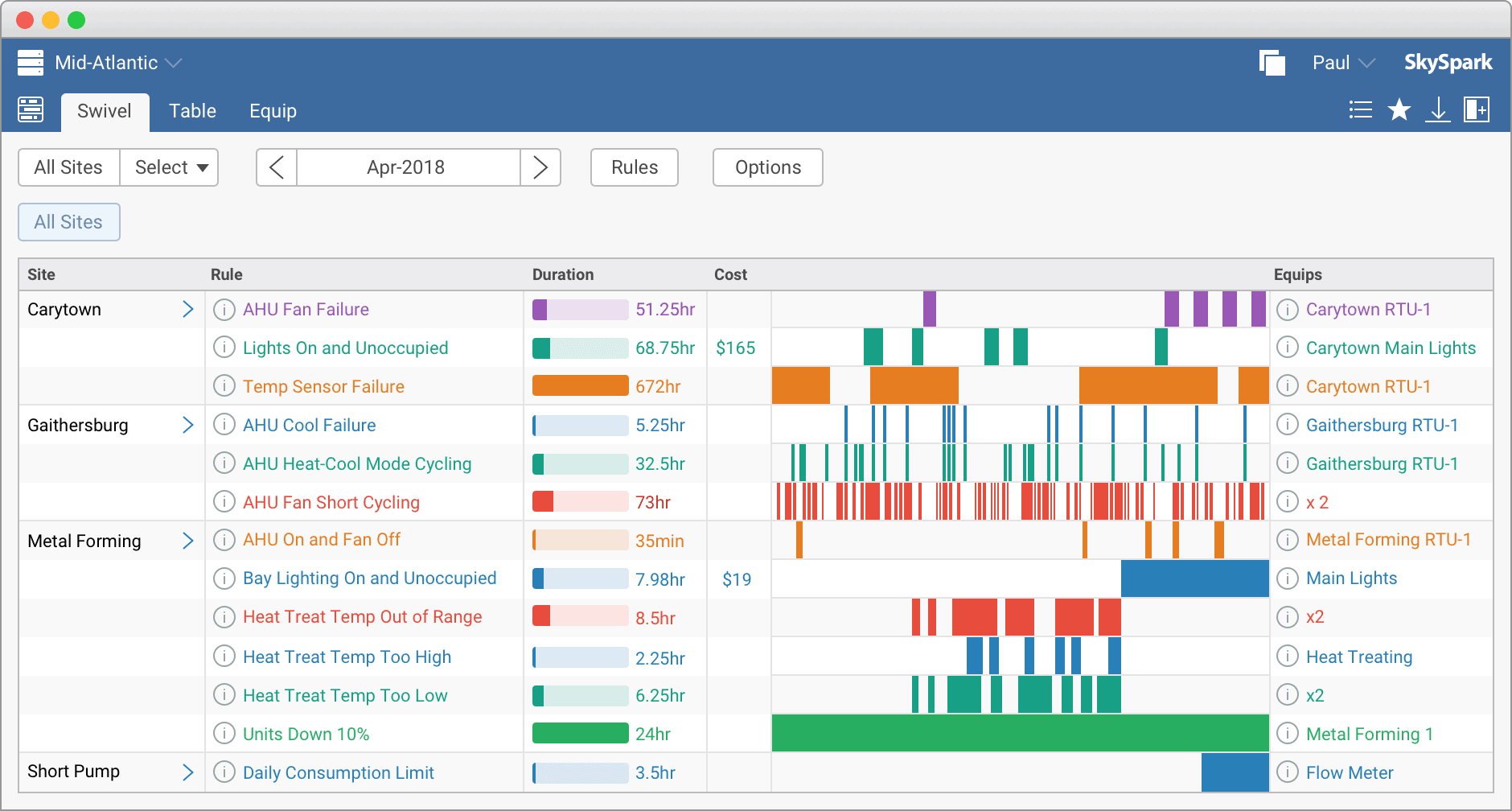
Skyspark is a simple generic IoT monitoring utility that allows you to track a variety of devices. The focus is on enabling you to monitor a broad spectrum of data on typical IoT devices rather than specializing in industrial or logistics. By grouping devices into nodes, you can span a surprisingly comprehensive set of data, meaning Skyspark is suitable for small, medium, and even large-scale businessesFurthermore.
Key Features:
- IoT monitoring FOLIO database
- Data filtering and tagging
- Substantial reporting/data exporting tools
- Modular apps for additional features
- Customizable dashboard
Additional functions can be added via separate apps, such as checking resource demand such as electricity and water consumption. You can produce reports on any subset of monitored data or export it outside the application as a CSV or PDF file. Skyspark is perfect if you’re working with a broad range of IoT devices and need to monitor them concurrently.
Pros:
- Features built-in filters to extract key data for specific insights
- Offers granular data collection settings
- Can monitor the performance and uptime of each IoT sensor
Cons:
- SkySpark is fairly enterprise-focused and might not be the best option for smaller IoT networks
Skyspark runs via Java and is supported by any platform that can run Java applications. You can purchase a license directly from Skyfoundry or via one of their partners. They do not offer any form of the Furthermore, free trial and the basic license costs around $60 for a one-time purchase.
2. Senseye PdM
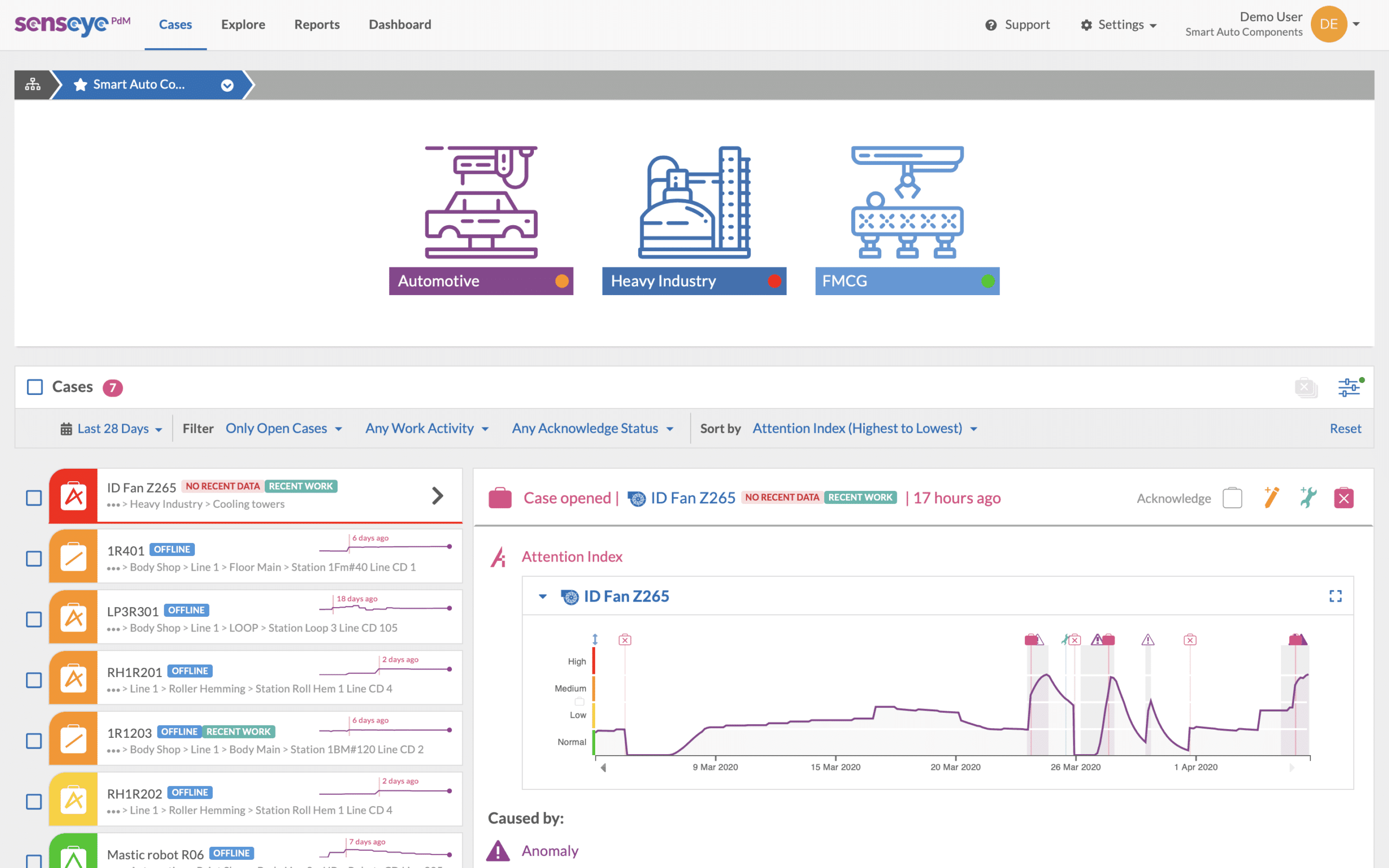
Senseye PdM is an industrial IoT monitoring solution designed specifically for factory equipment. The focus is on cutting maintenance and downtime on IoT-connected shop floor equipment by providing an overview of equipment status and uses predictive algorithms to eliminate unexpected downtime.
Key Features:
- Factory floor equipment monitoring
- Predictive maintenance
- Central monitoring dashboard
- Broad catalog of compatible machinery
- Substantial reporting tools
This enterprise solution is only helpful for factories that rely upon many interconnected robots, such as within the automotive industry. However, it is one of the best solutions for managing a swathe of IoT equipment and is worth considering if you need a software monitoring solution for your factory floor.
Pros:
- Focuses on providing IIoT solutions
- Great visual reporting – uses color well to highly critical metrics
- Operates in the cloud making it easy to scale
Cons:
- Some features catering to industrial IoT might not be applicable to all businesses
Senseye PdM Complete has a full range of utilities. Still, you can also select several individual packages such as Senseye PdM Enterprise and Senseye PdM Omniverse to adjust what features you require granularly and expand on the capabilities of the base product. In addition, you can contact Senseye directly to book a demo and get a personalized quote on pricing.
3. Datadog IoT Monitoring
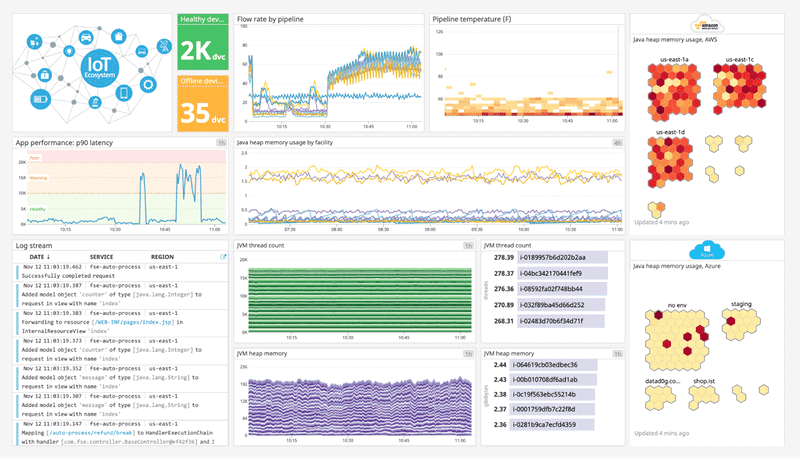
Datadog IoT Monitoring provides an enterprise-level industrial solution that can allow you to monitor a massive variety of data sources across a global scale while aggregating performance and maintenance data into a single point. The focus of the software is on collating IoT fleet data within the transportation and logistics fields.
Key Features:
- Distributed IoT monitoring for transportation and logistics
- Aggregate data through tags
- Monitor performance through a central dashboard
- Anomaly detection alerts
- Device health reports
The software can generate location heatmaps from telemetry data and allow an administrator to tag their IoT transportation routes for better feedback and aggregation. While the software is impressive, it is only for suitably large-scale businesses focusing on monitoring logistics networks.
Pros:
- Easy-to-use customizable dashboards
- Cloud-based SaaS product allows monitoring with no server deployments or onboarding costs
- Supports auto-discovery that builds network topology maps on the fly
- Changes made to the network are reflected in near real-time
- Allows businesses to scale their monitoring efforts reliably through flexible pricing options
Cons:
- Would like to see a longer trial period for testing
There is a free 14-day trial available for the software, but you’ll need to contact the company directly for a personalized quote on pricing for the full license. The software agent supports more than 450 IoT technologies, and the solution can be managed and viewed from anywhere on or outside your network.
4. Teamviewer IOT
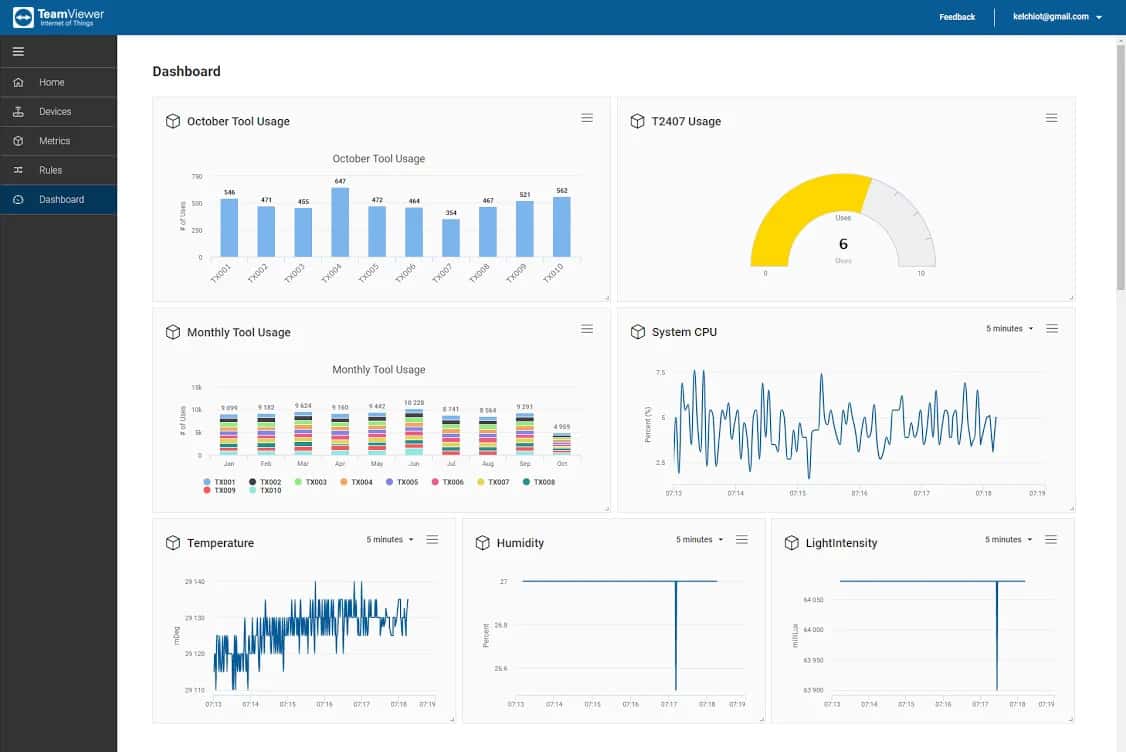
You probably know Teamviewer for their remote access software, but they also have an industrial IoT monitoring product simply called Teamviewer IoT. The software is built from the ground up with large-scale industries such as manufacturing and logistics in mind and can handle various industrial fields. So while Datadog is focused on transportation, and Senseye is focused on manufacturing- Teamviewer IoT can take both simultaneously and more.
Key Features:
- Broad range of industrial purposes
- Customizable dashboard
- Monitoring alarms
- Widely integrated
- Completely free on just two endpoints
The system can integrate with an impressively comprehensive source of IoT devices and integrate with ITSM solutions such as Salesforce. The client provides a dashboard for monitoring and reporting a customizable set of data, and you can set up alarms to anomalous flag issues. This solution is best to integrate industrial IoT across various fields rather than specializing in one.
Pros:
- Offers a free tier for up to two sensors
- Uses a simple (and familiar) dashboard to manage your sensors
- Offers customizable security features with encryption enabled by default
Cons:
- Only available as a cloud-based solution
Teamviewer IoT can be installed on two endpoints entirely for free through the Free IoT Journey offer. This allows you to test out the software before committing; alternatively, if you’re just looking for a small personal IoT solution for a couple of devices – perhaps at home or in a small business, this might be worth looking into. Beyond the two accessible endpoints, you’ll need to contact the sales team directly for a personalized quote on pricing.
The software boasts a significant amount of integrative solutions, including Zendesk, Amazon Workspaces, and IBM Maximo, to name a few.
5. Hologram IoT
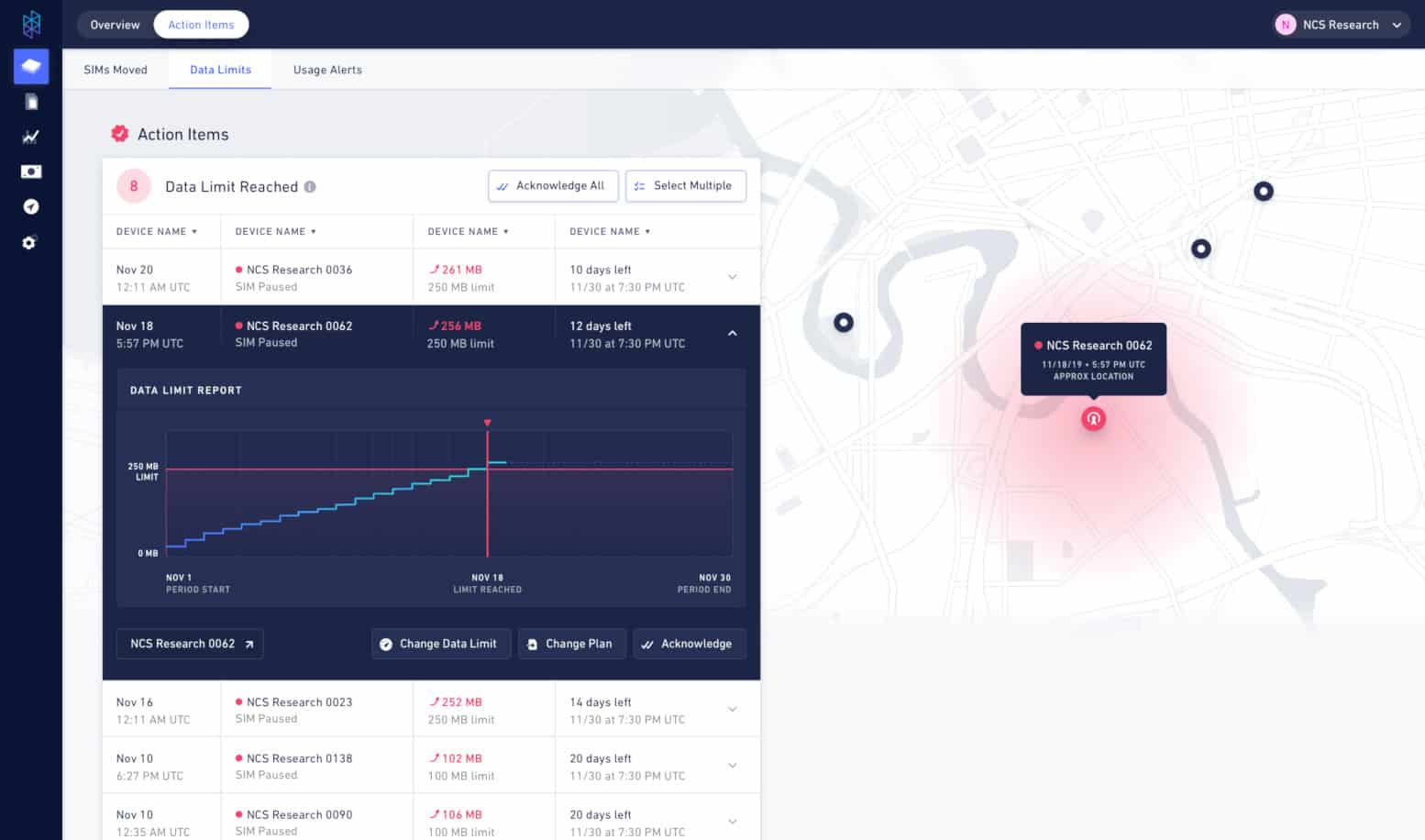
Hologram provides a cellular IoT solution that offers helpful but straightforward monitoring information about any connected cellular IoT device. Cellular IoT functions by using SIM cards to connect via 4G to a central host, where they can be monitored and managed remotely. Because of this, Hologram is best used in the transport and logistics field or in any industry where there are multiple IoT devices spread across large distances.
Key Features:
- Cellular IoT monitoring
- Check data limits and costs
- Data usage alerting
- Lots of supported technologies
- REST API integration
Hologram’s monitoring functions surround the cellular side of things, like tracking data usage or activation times. Of course, this solution won’t be viable for everyone, but if you’re explicitly using a cellular IoT network, Hologram might be the best fit for you.
Pros:
- Cellular-focused IoT monitoring
- Ideal for larger IoT deployments
- Simple interface – easy to manage and monitor
Cons:
- Not as flexible as other solutions
- Not ideal for IoT networks using other mediums outside of cellular
Pricing for Hologram is handled like a typical flexible mobile contract, with separate costs for the data plan and SIM cards. The standard SIM card costs $5 individually or purchased in several bulk options that significantly reduce the price, such as 100x SIM cards for $400.
The data plan options are entirely scalable to a specific number of devices, but it costs $1.50 per month for an individual data plan, with additional costs per MB of data. Though the cost does decrease as more devices are added to the data plan.
6. OpenRemote
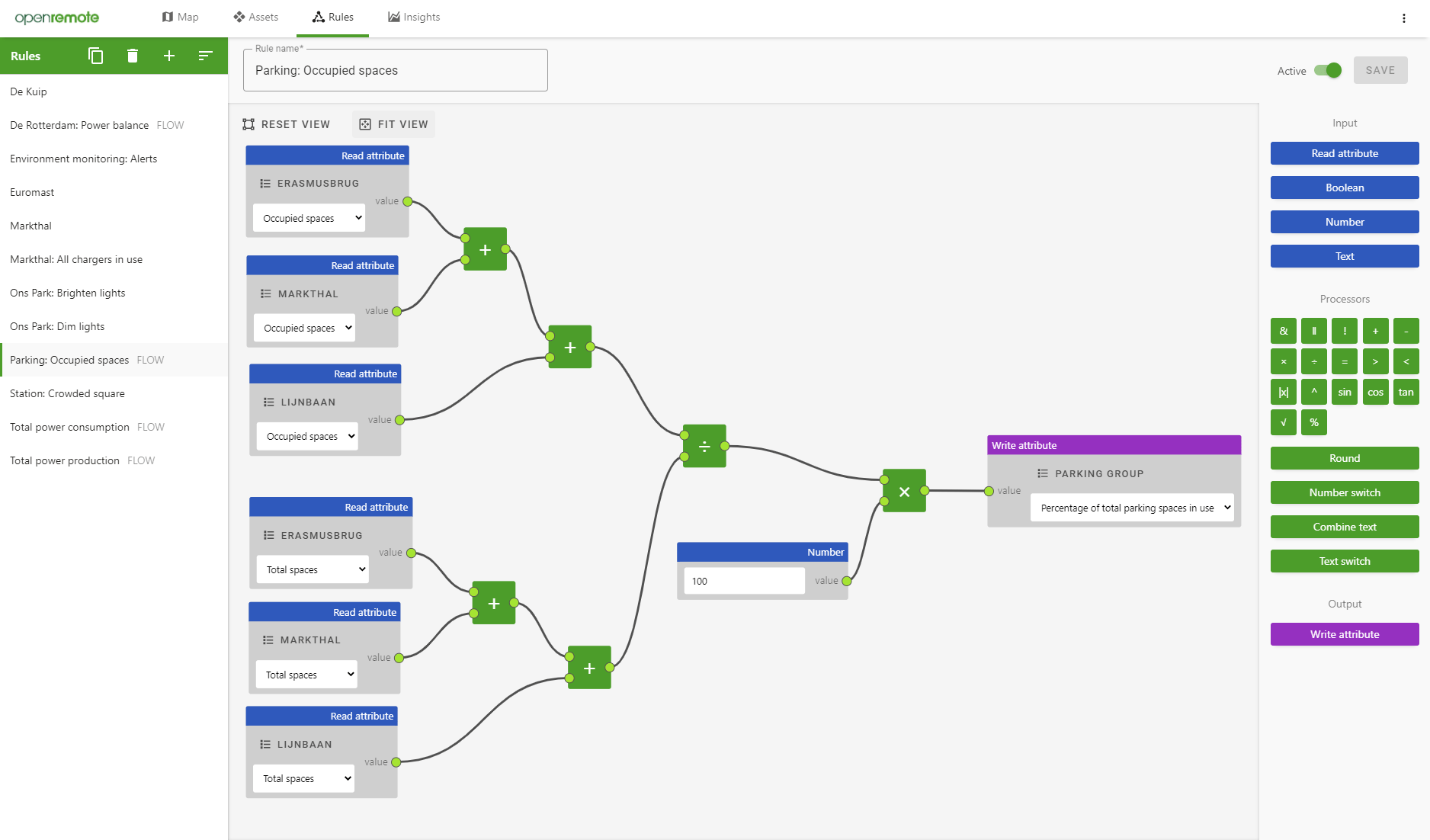
OpenRemote is an entirely free and open-source industrial IoT platform. The platform provides the capabilities to create a fully personalized dashboard of useful monitoring data, combined with task automation and location tracking. Because the platform is open-source, various systems are designed to expand on the system’s basic capabilities. It can be edited and developed to suit your specific needs further.
Key Features:
- Open-source and free
- Widely integrate with development
- Data visualization dashboard
- Task automation
- Mobile application available
This option is perfect if you have the time and ability to develop your backend. It’s also likely the best solution if you are running on a budget since it is the only wholly free solution available on this list.
Pros:
- Completely open-source platform
- Best for businesses on a budget
- Robust community support
- Highly configurable
Cons:
- Not the best option for larger enterprises
The OpenRemote controller is available to download for free from here. However, the platform is built on Java, so if you plan to customize or develop the system, you’ll need comprehensive knowledge of the language.
7. Particle
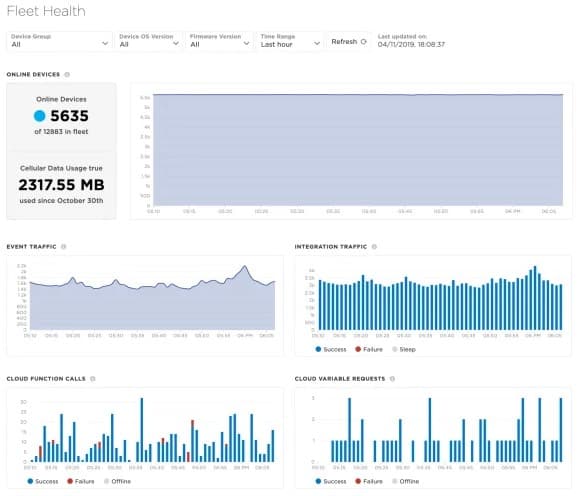
Particle is another primarily cellular IoT solution that provides far more detail in reporting and monitoring functions. The trade-off being that Particle also requires specific Particle-brand hardware to be integrated into your IoT devices directly, which they sell separately.
Key Features:
- Hardware development with manual integration
- Cellular IoT options
- Customizable dashboard
- Inbuilt API
- Cloud platform integration
If you can set up the hardware and manually integrate your IoT devices, the range of monitoring available to you is limitless. Still, you’re effectively doing a lot of the hard work yourself. Data is viewable from a customizable dashboard. Because the kit is installed by yourself, the range of possible uses the technology can serve is vast across all fields that might use IoT devices.
Pros:
- Combination of a hardware and software solution
- Uses simple Ardunio kits to collect data
- Extremly flexible – ideal for any size IoT operation
Cons:
- Not ideal for businesses using their own hardware monitoring
Using Particle hardware is akin to an Arduino setup, except with a fully included software suite to go alongside the hardware. The significant difference is that you can push updates through the Particle website to your devices remotely over the cellular network. If you or your business are familiar with developing alongside an Arduino or similar kits, this may be the best solution for you.
Much like Hologram, Particle pricing is divided between paying for the hardware and the data plan (including the management console). They have a wide range of hardware options since you’re buying the development board and the SIM together. The typically SIM-included development board is the Particle Boron, which costs $60 per unit.
For the data plan, Particle offers a free program that supports up to 100 devices and 100k data operations per month. Beyond the free plan, there is a Growth (for small-medium businesses that exceed the limitations) and an Enterprise option.
8. AWS IoT Device Management
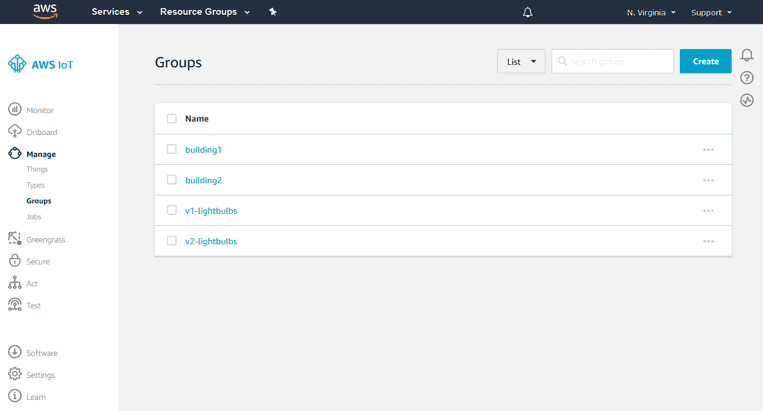
One of the numerous expansions for AWS is the IoT Device Management package, which, as you might imagine, seamlessly integrates into an existing AWS setup with very straightforward installation and maintenance. AWS IoT is one of the more barebones options on this list in terms of monitoring capabilities, providing simple options for various IoT device types.
Key Features:
- Device management and organization
- Bulk task execution
- Barebones monitoring
- Modular features and pricing
- Quick and easy installation
The system’s primary function is administrating and executing tasks across an AWS integrated IoT network. This solution doesn’t pose much in aggregate data monitoring or reporting, but it might be the best solution if you already use AWS and just need simple management tools to handle your IoT devices.
Pros:
- Highly scalable – great for enterprise IIoT
- Best for businesses already using the AWS ecosystem
- Easy to understand pricing
Cons:
- Is more barebones in terms of reporting than competing products
For the IoT Device Management expansion, you must obviously be using AWS. The solution itself is priced modularly based on whatever functions you need. Still, in addition, because of. Still, its example, the Bulk Registration feature is priced at $0.10 per device (per 1,000 devices). Most of the additional functions surround the management of your IoT network rather than monitoring, so you may find that if your primary purpose is monitoring, you don’t need most of them.
You can use this page to check the various additional features available and determine your costs precisely.
In Summary
To find the right solution for yourself, first, make sure you consider what IoT systems you plan on using and if they fall into the capabilities of one of the various specialist solutions on this list.
For example, if you need software monitoring for IoT-enabled shop floor equipment, Senseye PdM is probably the best solution. On the other hand, if you rely on specifically cellular data tracking, then Hologram IoT is a no-brainer.
Alternatively, if you use a broad range of IoT solutions, you might want to consider using a flexible solution. For example, Skyspark is the best option for enterprise-level monitoring for flexible IoT systems. Still, if you’re on a budget and have the development abilities, OpenRemote might be the better option.
It’s also important to note that there’s no reason why you can’t use multiple options. For example, while special centralized monitoring is handy, you could feasibly use a specialized solution for one crucial part of your monitoring needs while relying on a flexible option for everything else. Consider combining solutions if one alone isn’t enough for your purposes, and you may be surprised to find they integrate (especially in the case of AWS IoT Device Management).